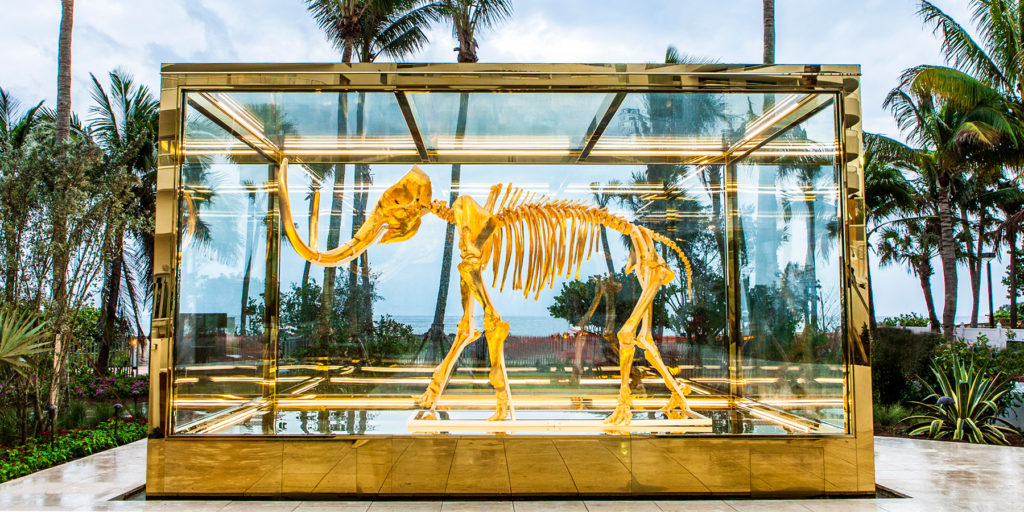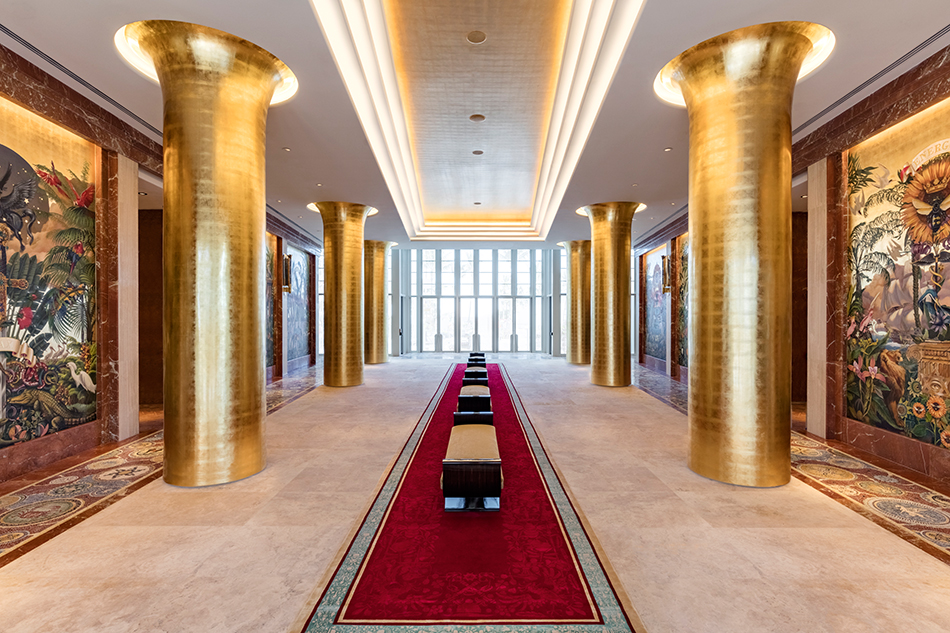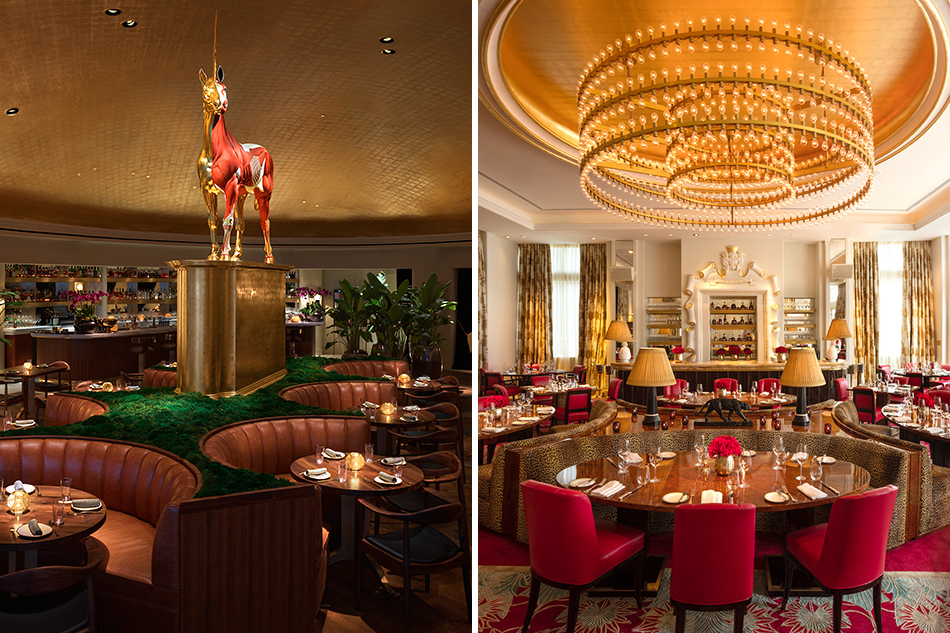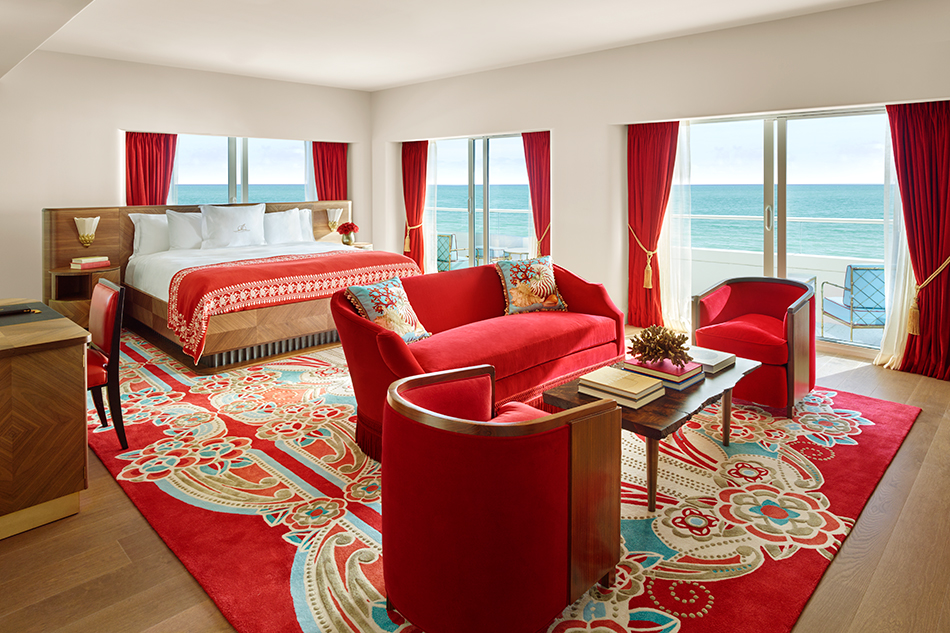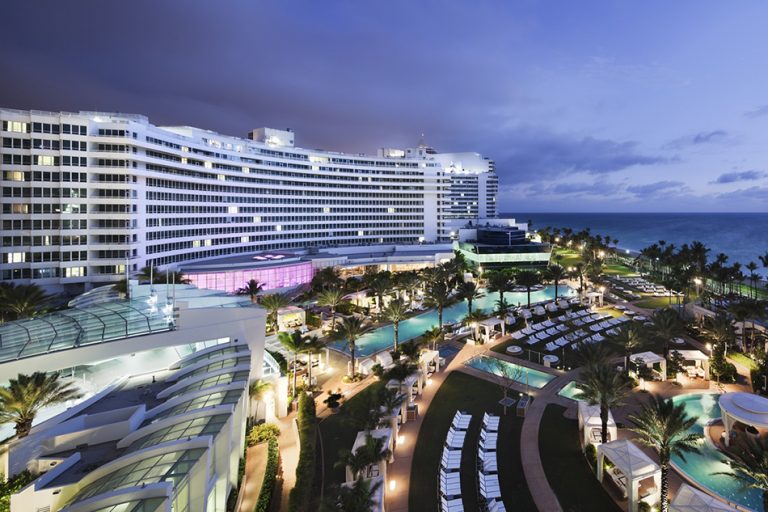
June 6, 2016Argentine real-estate developer Alan Faena and his partner in design and in life, Ximena Caminos, have opened the ambitious Hotel Faena on a previously dreary stretch of Miami Beach (Photo by BFA). Top: The property features numerous works by world-class artisans and artists, including Damien Hirst, whose gilded mammoth skeleton, Gone But Not Forgotten, 2014, is on display for both hotel guests and passersby on the beachside boardwalk (photo by Ivan Belaustegui). All photos courtesy of Faena and noted photographers
In the Living Room bar of the 169-room Faena Hotel Miami Beach, perhaps the city’s most distinctive new property, the super-saturated red-and-gold theme of the rest of the hotel is in full evidence. But unique to this space is the riot of animal prints on the custom furniture. And to drive the design-safari theme home, two large ceramic sculptures stand guard, one of a tiger and one of a cheetah.
“We were wondering if it was too much tiger, too much cheetah,” designer Ximena Caminos says with a smile. “So we decided to do more.” Caminos is one half of the duo behind the newly christened six-block-long, $1.2 billion Faena District (which includes the hotel and more than 100 condominiums), along with her life partner, the tireless real-estate developer Alan Faena.
The more-is-more philosophy wouldn’t succeed if Caminos and Faena weren’t so committed to art and artisans, whose work constitutes the vinegar in the salad dressing of this massive project, the element that provokes thought and what Caminos calls “spiritual turbulence,” to balance out the rich luxury. Hanging above her as she talks is a massive and unusual chandelier that is one of two site-specific artworks she commissioned from Alberto Garutti. Titled Storms, the cylindrical pieces flicker every time lightning strikes Argentina’s famed grassy Pampas region.
The proof of their dedication is certainly provided by Faena Forum, the multidisciplinary cultural center designed by Rem Koolhaas and his Office of Metropolitan Architecture team and scheduled to open in October. The domed building, with an ingeniously self-supporting wraparound skin, will host an inaugural event involving a procession through the streets directed by the dynamic independent curator Claire Tancons, and instead of art exhibitions, the Forum will be geared toward performances, debates and other “time-based” events. The modern dance piece Tree of Codes, a work by Wayne McGregor, Olafur Eliasson and Jamie xx that was presented at the Park Avenue Armory last fall, was co-commissioned by Faena Art and several other international arts organizations, and will appear at the Forum next year.

The rehabbed property’s facade still displays the Art Deco influences of its previous incarnation, the Saxony hotel, built in 1947. Photo by Todd Eberle
Faena and Caminos could have been successful just building a hotel and some condos, as many have before them and will in the future. But they — along with their essential and deep-pocketed partner, the Ukrainian-American financier Len Blavatnik — invested $150 million in the Forum, which is both something very much needed on the Miami scene and a boffo example of a real-estate development “amenity.”
The hotel, on the Atlantic Ocean at 32nd Street, is only one of the Faena District components enlivening the formerly sleepy area known as Mid-Beach. It reimagines the Saxony Hotel, which dates to 1947, putting a contemporary-art spin on Art Deco gloss, with hardwood floors, red velvet everywhere and bathrooms tiled in a cool blue. The Forum is across the street, and next door to the hotel is Faena House, a sleek black and white condo building by Sir Norman Foster with bumper-like, rounded terraces. Coming in the future are Faena Versailles, two adjacent condo buildings by Brandon Haw and William Sofield, and the OMA-designed retail space Faena Bazaar.
Faena himself, always dressed all in white, including a white Panama hat, is a former fashion designer who knows how to put on a show. Between 2004 and 2011, he famously rehabilitated the entire Puerto Madera area of Buenos Aires, restoring a hotel and establishing an art center, which together set off a chain of unrivaled gentrification..
“This is where I live,” he says, sitting in the design trailer of the Faena construction offices, with a large swatch of rose-colored damask behind him. He and his team meet here constantly to mull over every aspect of the development, no matter how small. “The most difficult part of the whole project was the design of the hotel,” he says. “Everything you see passed by this seat, passed by my hand.” Faena pauses. “I’m a storyteller,” he says. “I just tell my stories in buildings.” That explains why, for a time, film director Baz Luhrmann and his wife, the scenic and costume designer Catherine Martin, were brought in for consulting services, encouraging them to go even bigger and bolder than they normally would.
“I’m a storyteller,” Faena says. “I just tell my stories in buildings.”

Leather banquettes and a palm-print wallcovering in Pao recall the city’s golden age. Photo by Todd Eberle
Faena and Caminos met through the Buenos Aires project and have a son. They don’t like to be profiled as a couple, and don’t even do interviews together. But regarding the whole Faena District, Caminos acknowledges, “Like our houses, we do all this together.”
Caminos’s official title is executive director of the Forum, and she spearheads the serious art elements. Faena is a world-class detail man across all aspects of a project. He has been spending several hours a day getting the hotel’s jewel-box-like cabaret theater up and running, even giving notes on the lighting. Encased in deep red leather and velvet, the space definitely channels South America, as does the programming, invoking to some combination of Art Deco glamour and contemporary performance art.
The hotel is divided in two parts. You enter through a vaulted space called the Cathedral, which serves as the spine of the hotel. To the right are the entrance to the restaurant Pao, an oval space anchored by Damien Hirst’s massive unicorn sculpture, Golden Myth (2014); a private dining area; and the theater. To the left are the lobby and the rooms, as well as the Living Room bar. Through the glass at the far end of the Cathedral, you can see Hirst’s Gone But Not Forgotten (2014), a glass-encased gilded skeleton of a wooly mammoth that stands outside between the hotel and the beach and serves as a frequent Instagram background for both hotel visitors and passersby on the boardwalk.
Craft is everywhere. “I love these artisans,” Faena says of the many talents involved. Argentine legend Juan Gatti (who is also directing the theater’s opening show) painted the eight large site-specific murals that take up the Cathedral’s considerable wall space. Titled Way to Futopia, they play against the space’s gilded columns with their florid, lush scenes and rose motifs, which are a keystone of the Faena mythology.

Just beyond the Cathedral, Tree of Life, a site-specific work by Antwerp design collective Studio Job, dominates an outdoor dining area. Photo by Todd Eberle
When Faena was told he couldn’t successfully grow roses at his Uruguayan beach retreat, he resolved to do it and prevailed against the naysayers. That same perseverance has marked his steady upward climb, from 10 years in the fashion business creating and then selling a line called Via Vai to embarking on the Argentine real-estate ventures in 2000 in partnership with Blavatnik. “I think the murals have balls,” Caminos says, laughing, noting that they were proposed by Luhrmann and Martin. “They are really daring.”
Studio Job, the heralded Antwerp-based design collective that is represented in many top museums, has been heavily involved, too. In addition to site-specific installations (Faena Fountain and Faena Tree of Life, which also incorporates tiles by Gatti), it has helped created the symbology throughout the hotel, including the hat icon (modeled after Faena’s panama) that appears on the burnished wooden doors leading to the lobby, as well as the mosaics and carpet patterns in the Cathedral.
The layering of materials and ideas has produced a thoughtful retreat, where people seem slightly less likely to be on their smartphones all the time — the spaces are quiet, not clattery, and encourage human interaction. Both Caminos and Faena say that they have tried to create the opposite of a “Miami party place.” They are classic connector types, bringing together artists, craftsmen, architects, chefs (their friend the Argentine star chef Francis Mallman heads a restaurant in the hotel, Los Fuegos) and other creatives. “We’re good at attracting interesting people and being able to mix them,” says Caminos.
That ability is one of the reasons they are besieged with offers to work their transformative magic in other cities (Los Angeles has been floated as a possible location). But right now, they have just enough energy to finish what they started in Miami. “We are warriors, and we have been fighting a war for five years,” says Caminos. “Multitasking like this frays your nerves. But it’s our passion.”
They are conscious that with the hardware largely completed, the “software” — things that create the hotel experience — requires constant vigilance. Caminos returns to a metaphor embodied by the ceramic animal statue on her left. “Having a hotel is like having a tiger in your backyard,” she says. “If you don’t feed it, it will eat you.”
